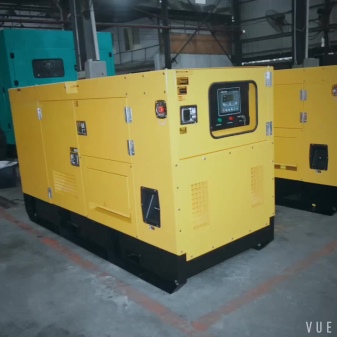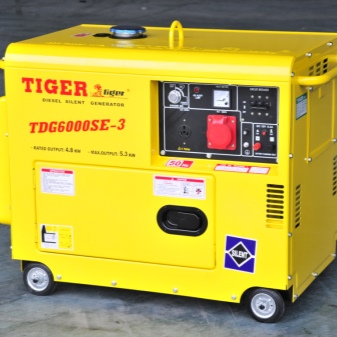Design and selection of single-phase diesel generators

Modern man is accustomed to the benefits of civilization, many of which are impossible without the use of electrical appliances. Therefore, those who are going on a long hike or want to create a power supply system for a country house should familiarize themselves with the features and principles of the device single phase diesel generators and consider recommendations for their correct selection.

Peculiarities
Diesel power generators have a number of noticeable advantages over gasoline ones:
- higher efficiency - the diesel version consumes less fuel than its gasoline counterpart of the same power;
- higher level of security - diesel fuel is more fire safe than gasoline, therefore, the operation of a diesel device and storage of fuel for it are associated with a much lower risk of fire;
- profitability - diesel models are cheaper than gasoline devices of similar power, and fuel for them is usually cheaper;
- reliability and maintainability - a diesel engine, if properly operated, works longer than a gasoline engine (up to 40,000 operating hours before the first overhaul), and its maintenance is cheaper;
- environmental friendliness - the exhaust gases from such models contain less harmful impurities (especially carbon monoxide) than the exhaust of gasoline devices.

This technical solution also has disadvantages:
- diesel devices have a higher noise level than gasoline ones;
- diesel engines cannot be kept idling for a long time, otherwise rapid wear of engine parts is possible;
- such generators are more sensitive to the composition of the fuel than their gasoline counterparts, while the presence of impurities or deviations from the optimal composition can lead not only to the termination of the engine, but also to its breakdown.

The main difference between single-phase and three-phase generators is that they are capable of supplying power to only those devices that are designed for a supply voltage of 220 V.
This limits the scope of their application to tourism and household networks, since many industrial units require power supply from a three-phase network with a voltage of 380 V.


Device
Structurally, the diesel generator consists of 4 main units:
- a diesel engine that burns fuel;
- an electric generator to which torque is transmitted from the motor;
- control unit for starting and stopping the device;
- fuel tank.


Also the generator usually includes various auxiliary devices, namely, the power conversion unit, the cooling system (on closed models), the electric starter (on the high power models) and the exhaust system.


Views
All single-phase diesel generators are divided into 2 groups according to the housing design:
- open - in them, the motor and generator are fixed on a metal frame;
- closed - all elements of such a device are located inside a sealed case.


According to the starting system, generators are divided into:
- manual - in them, the diesel engine is started manually;
- with electric starter;
- with autostart - such devices monitor the presence of electric current in the network connected to them and, in the event of its disconnection or voltage drop, are automatically turned on to ensure the operation of the devices connected to the network.



Among single-phase options, the most common are the following power values:
- 2 kW - usually these are lightweight portable generators designed for short-term operation in the conditions of a tourist trip (for example, "Vepr ADP 2.2-230 VYa-B" and Yanmar YDG 2700 N-5EB2);
- 5 kW - either tourist generators for long hikes, or solutions for backup networks or autonomous networks with a small number of consumers have such power. This category includes such models as "Centaur KDG505EK" and Forte FGD6500E.
- 10 kW - full-fledged options for creating a backup or autonomous power supply system at the dacha or at a construction site, for example - "AMPEROS LDG12 E" and Hyundai DHY 12000SE.
- 15 kW and above - devices with such power are semi-professional.


Selection Tips
When choosing, it is worth considering such device parameters.
- Power - the maximum load that can be connected to the equipment depends on this characteristic. To estimate the value of this value, it is worth adding up the maximum power of all electrical appliances that you plan to connect to the generator. At the same time, in order to avoid breakdowns and emergency shutdowns, it is better to purchase a mini-power plant with a power reserve of 50% to 75%.
- Type of shell - open versions are cheaper, cool much better and are easier to repair, while models with a closed case have a lower noise level and a significantly higher level of protection against dirt, moisture and mechanical damage. Therefore, if the device is supposed to be installed indoors, then an open generator will be sufficient, but for installation in the open air, it is worth purchasing exclusively closed versions.
- Battery life - if you plan to use the generator occasionally, and refueling it is not a problem, then in order to save money and space, you can purchase a device with a battery life of 2 hours or more. If the equipment must ensure the stable operation of electrical appliances as part of a backup or main power supply system, then you need to choose models with an operating time of 10 hours or more before refueling. Preference should be given to devices in which it is possible to replace the tank with a more capacious one.
- Noise level - this indicator depends on the design of the device and the properties of the engine used in it. Depending on the model, it ranges from 65 to 90 dB.
- Fuel consumption - the lower this indicator, the cheaper the operation of the device will be.


In the following video, you will learn how to choose the right diesel generator.













The comment was sent successfully.